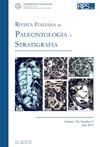英国约克郡卡德比采石场卡德比组Lopingian(晚二叠世)岩形岩
IF 1.9
3区 地球科学
Q2 GEOLOGY
引用次数: 0
摘要
来自英国南约克郡唐卡斯特附近Cadeby采石场Cadeby组(Lopingian,二叠纪,EZ1)的17个样本产生了有机残留物,包括植物碎屑、角质层、非结构化组织和通常保存完好的坡缕石。花粉形态组合以带束和非带束双壳花粉为主,包括沙氏Klausipolenites schaubereri、矩形Limitisporites rectus、virkkiae Lueckisportes和Novaulensis带束孢。这些组合通常类似于诺丁汉郡金伯利铁路切割和霍顿霍尔钻孔中描述的英格兰中部地区的组合,以及Claxheugh Rock和Crime Rigg采石场达勒姆次盆地Marl Slate地层(下EZ1)和Salterford Farm钻孔和Woolsthorpe Bridge钻孔的EZ1中部的组合。对这些组合的出色保存使人们认识到,蒂瓦里和维贾亚的Dicappipollenites Tiwari&Vijaya 1995是波托尼和克劳斯的初级同义词。克拉克1965年。稀有的微小浮游生物和微小有孔虫测试衬里的存在表明了近海海洋环境。Cadeby组的碎屑(和有机)含量,主要是碳酸盐岩序列的一部分,可能代表了内陆物质的侵蚀和运输,反映了一个更潮湿的气候时期,尽管Cadeby剖面中碎屑和碳酸盐沉积的交替表明了一些潮湿/干燥的古气候循环性。本文章由计算机程序翻译,如有差异,请以英文原文为准。
LOPINGIAN (LATE PERMIAN) PALYNOMORPHS FROM THE CADEBY FORMATION, CADEBY QUARRY, YORKSHIRE, UK
Seventeen samples from the Cadeby Formation (Lopingian, Permian, EZ1) of Cadeby Quarry near Doncaster, South Yorkshire, UK, yielded organic residues including phytoclasts, cuticle, unstructured tissue and generally well-preserved palynomorphs. The palynomorph assemblages are dominated by taeniate and non-taeniate bisaccate pollen including Klausipollenites schaubergeri, Limitisporites rectus, Lueckisporites virkkiae and Taeniaesporites noviaulensis. The assemblages are generally similar to those from the English Midlands described from Kimberley Railway Cutting and the Haughton Hall Borehole, Nottinghamshire and those from the Marl Slate Formation (lower EZ1) of the Durham Sub-basin at Claxheugh Rock and Crime Rigg Quarry and to the mid EZ1 of the Salterford Farm Borehole and Woolsthorpe Bridge Borehole. The excellent preservation of the assemblages allows the recognition that Dicappipollenites Tiwari & Vijaya 1995 is a junior synonym of Lueckisporites Potonié & Klaus emend. Clarke 1965.
The presence of rare microphytoplankton and microforaminiferal test linings indicate a neashore marine environment. The clastic (and organic) content of the Cadeby Formation, part of a dominantly carbonate succession, may represent erosion and transport of material from the hinterland reflecting a wetter climatic period, though the alternation of clastic and carbonate sedimentation in the section at Cadeby suggests some wet/dry palaeoclimatic cyclicity.
求助全文
通过发布文献求助,成功后即可免费获取论文全文。
去求助
来源期刊
CiteScore
3.60
自引率
4.30%
发文量
28
审稿时长
>12 weeks
期刊介绍:
The Rivista Italiana di Paleontologia e Stratigrafia was founded in 1895. It publishes original papers dealing with all fields of paleontology and of stratigraphy, from Italy and the Mediterranean to the Tethys, as well across the globe from China to North America.

 求助内容:
求助内容: 应助结果提醒方式:
应助结果提醒方式:


